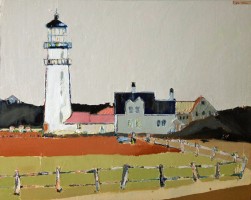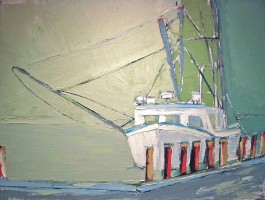Part 2: As I said in the prior post, there is so much that goes into an art show, especially a solo show, and typically the last thing you think about is the press interviews. Here is interview/article #2 by Pierre Tristam of FlaglerLive.com.
The interview was intense, starting from childhood and going to present-day yet it was the way the questions were raised that had me connecting my own dots and pondering for days afterwards. The best learning from this one was about scheduling your time. It took place between 6 and 8PM after a long day of hammering and wiring more than 30 of my paintings. But hey, the article is very generous and I am thankful for the support and assistance and coverage Pierre so generously gave me. Enjoy!
____________________________________________________________________
At Hollingsworth Gallery:
Christine Sullivan, Artist of the Yearby Pierre Tristam, Friday, November 8, 2013, FlaglerLive.com
You can spot a Christine Sullivan painting from a mile away, and not only because many of her works intentionally place you at that remove from their characteristic subjects: the far-away barn, the lone boat, the undulations of seaside dunes, the slumbering cove, a shoreline farm seen from above, like those Google satellite maps, but with Milton Avery colors, and of course, especially in her more recent paintings—the works at the heart of her solo exhibit opening at Hollingsworth Gallery Saturday—the clotheslines, the recurring clotheslines that are like her earthbound version of boats’ masts and riggings. The signature is distinctive.
The sparseness is evocative not of distance or isolation but of intimacy, of something as familiar as the feel of a favorite blanket in winter. Sullivan’s sceneries are the continuation of life by other means: memory and geography and nature, “that feeling that when we’re alone, we’re not alone,” she says, echoing the words of Ann Packard, the Cape Cod painter whose lone, empty boats recur as often as Sullivan’s clotheslines. She is reflecting, she says, “that unspeakable feeling when you’re painting, when you’re off by yourself, taking a look at the ocean, you’re in the environment, you’re in the landscape. There’s this feeling that we’re all connected, and I think that feeling comes from that feeling of connectedness with the earth and all living things.”What you don’t see is people, animals, the clutter of living, noisy things. It appears to be all absence, as if Sullivan has a thing for neutron bombs, the kind that eradicate life while leaving everything else intact. But there’s nothing desolate about what you’re seeing, certainly nothing sad or mournful about it. You want to keep looking, and you do, sometimes at the same painting for long periods, because it draws you in. The colors are understated. The seduction isn’t.
The intimacy doesn’t stop with the scene on the canvass. Sullivan’s technique, the occasional drafts of drawings still visible beneath the paint, the cuts in the paint, the intentionally unfinished look—no landscape is ever finished, after all—bring you into her studio. That connectedness again.
What’s less discernible is how recent Sullivan’s mastery of oils happens to be. At 56, she’s spent most of her life either surrounded by art in a family of artists or practicing it in one form of another, even through her work as a cartographer and, from the mid-1990s until just a few years ago, as one of the creators of the Golf Channel in Orlando, where she oversaw all branding products, including advertising in all media. She’s also been a prolific writer, a keeper of journals, a poet, a blogger. But it’s only after she retired and permanently moved to Palm Coast in 2009 that she took up oils. It happened as she took one of JJ Graham’s very first classes at his then-nascent Hollingsworth Gallery, as she started dropping in there once a week, then twice, then three times, then daily, then rented a small span of wall where she could paint every day, and did, then a studio of her own in back of the gallery, and then, and then.
“Show up. Isn’t that half the battle?” she says. She’d married, she’d held job after job, she’d raised a daughter (now in college). She now took on life as a full-time artist, painting seven days a week, starting at 10 or 11 and not finishing until 6 or 7 in the evening. With long breaks previously, she’d painted for years, but never oils. The 35 oil works on display in her Hollingsworth show are all from the past four years, and most are from the past two, the result of her faintly obsessive work ethic but also of her close association with Graham, the teacher who now realizes that a graduation of sorts quietly took place somewhere along the way. “She has the right attributes and the right work ethic,” Graham says, “so much so that at this point I don’t consider her my student. She’s my contemporary.”
It helped a lot that Sullivan’s evolution took place during the richest part of Hollingsworth’s young life, when it was itself a Cambrian explosion of artistic talent—with Graham, the late Richard Schreiner, Linda Solomon, Bill Brant and many others fuming up the place, several of whom taught at Hollingsworth. Sullivan soaked it all in. It’s paying off.
Saturday evening, with Palm Coast Mayor Jon Netts and many of her artistic colleagues present at Hollingsworth, she will be recognized as the 2013 Gargiulo Art Foundation Artist of the Year. Schreiner was the recipient in 2012, posthumously.
“My first emotion after I heard the news was to be following Richard Schreiner to get this award the year after he got it was—I mean, I just bawled my eyes out in the car and called Arlene,” Sullivan said, referring to Schreiner’s wife, who lives in Palm Coast and has also been an intimate friend of the Hollingsworth community. “It’s a humbling experience certainly when you look at the artists who have received the award. But to follow Richard: I’m hoping he had something to do with it, even though his was certainly overdue. I’m certainly not the caliber of artist that Richard was, but there’s certainly a bond that we had and a dear friendship.”
Schreiner’s work—dark, acidic, wry, politically engaged, exuberantly angry, often reveling in the unnatural—is everything Sullivan’s work is not, though the two artists shared that happy coexistence that Hollingsworth made possible. They had this in common: they were both as emotional as they were intellectual in the way they approached their work. True to the inviting intimacy of her method, Sullivan illustrates that approach in her blog. Take this segment from a July posting about “Turo Lighthouse,” one of the works in the new exhibit:
I arrived at the studio early this morning and read a bit of my Joseph Albers: To Open Eyes book and turned to look at where this painting was up till today. Covered in two, possibly three session’s worth of bright blues, greens and peach colored paint. Ugh.
Two days ago I was so mad at where it was going I just tossed it in the corner and painted a few others. Rather successfully I might ad. So this morning I decided I needed to remind the painting just who was boss (chuckle) and finally it hit me. My color strategy was entirely WRONG and the foreground had to change.
I went to work, first at the palette, developing a new family of warm, earthy colors and a few new greys, and then got to it. For the next hour I painted, changing almost every inch of the 24 x 30″ canvas and then, breathing, I stepped back and smiled.
The archetypes are all there: the distant lighthouse, the earthy colors, the fence (replacing the clotheslines or the riggings), the absence of anything like a human figure. Sullivan was a geography major and an art minor in college (Plymouth State University in central New Hampshire, where was attracted by the skiing opportunities). That absence of human figures only speaks of the pervasiveness of “this sense of place,” as she terms a theme central to her work. “It is so much about the relationship that we all have, not just with the land, but with all the people that share this land. Then it just spills over into all living things. It’s that connectedness that inspires me, and I think is the foundation of my work. It could be just the landscape, or that’s where the clotheslines come in, or the telephone lines. You know that a man or humans have been in this environment by some of the marks that I have in my work, and some of them are intentional and others just seem to happen.” Like the wind swelling the sheets on one of her clotheslines, a literal breath of life—a spiritual breath if you like—that visually captures life’s momentum Think of Henri Bergson’s élan vital, or “current of life,” powerful and irrepressible.
She’d lived her first years at a farmhouse outside Syracuse in New York, then in a suburb of the city, spending parts of every summer on Cape Cod and never knowing then that the years would have as deep an imprint on her understanding of the land as they would, as they do in her work. That’s the memory at work in the paintings.
“The word geography to me,” she says, “it’s that definition of our relationship with the land, and its relationship to us. That happens through folklore, it’s local history as well as just from what we do, we carve out a piece of this earth and we call it home. That becomes imprinted upon our soul because that’s what we identify with. That sense of home is so much more than a house and family. It’s all these colors and the environment of the land around us, the folks that feel about the purple mountains in Arizona and have that special relationship as we do here with our ocean and our sunshine, these wonderful skies that we have.”
And somehow that sense of place converged literally and artistically towards Hollingsworth.
“Of all the gin joints I walked into, did it just happen that I happened to walk in here? And then to meet Richard Schreiner? Then to take a class with Richard? Then with Brant?” Sullivan says. “Hollingsworth is this magnet of some sort, it has drawn all of us who have a desire to be with other people that see the same things and feel the same things that we do. All of our art work can look different, and please, I hope it does, but we all have this common ground. And JJ is right at the center of that.





